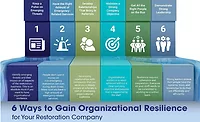Back to Basics: 10 Easy Ways to Ensure Your Company is Ready for Anything

When your company is facing a deluge of projects, whether that’s due to seasonal flooding or burst pipes, it’s easy to lose sight of the elements that ensure a quick response. Sometimes the day-to-day grind can take our focus off of the basics. So, to refresh your knowledge, we’re offering 10 tips to keep front of mind.
When a business has suffered a catastrophe, response time is critical. In part, that’s because almost every incident involves water damage—and the longer it’s unresolved, the greater the potential for secondary damage and conditions that foster mold and poor air quality. If you can prevent ongoing damage, you can save your client money and additional remediation and reconstruction work.
Also, every day your client can’t open an office building or factory or retail store, they lose money, usually lots of it. The revenue they forego dwarfs the cost of supplemental equipment and staff. Even one less day with the doors shut can make a major difference in their bottom line.
Speed Up Your Response Time
1. Start with sufficient staff and equipment. Make sure you always have enough people for a project and the right mix of project managers, supervisors, and technicians. Keep critical pieces of equipment in your own fleet but also establish an account and solid relationship with a rental company that can deliver additional machinery immediately when you need it.
2. Get to the job site quickly and assess the damage. Measure the square footage and determine what it consists of – a steel and concrete warehouse or a carpeted office space, for example – as well as its temperature and humidity. Determine what will need to be dried, restored, demolished, and/or reconstructed. Start creating a moisture map.
3. Get equipment headed your way. Don’t wait until you’re certain about what you need – many rental companies won’t charge for equipment that’s not taken off the delivery truck, so it’s better to overestimate. Size the equipment appropriately for the job, so you have enough ride-on and walk-behind floor extractors, air scrubbers, dehumidifiers, and anything else you might need for drying. Work with reliable vendors who can provide fueling and consumables too.
4. Bring in dehumidifiers ASAP. You’re aiming to decrease the humidity to below 60% within 48 hours. If it takes longer than that, you can expect secondary damage, including splitting wood and mold. Supplement with portable heaters or AC units, if necessary, to keep the temperature between 60°F and 80°F.
5. Hire the best project manager you can find. Make sure your project manager can envision the sequence of tasks and the people and equipment needed on site to perform the entire job from start to finish. By scheduling the right activity at the right time, you can avoid situations where the reconstruction crew wants to move lifts in but is blocked by the demolition crew’s dumpsters.
6. Build a good relationship with adjusters. Get to know the key people working for major insurance carriers in your area. Understand the claims process for insurance-related repairs and what each provider requires and covers. If you need to make decisions before the adjuster visits the project, use the Institute of Inspection Cleaning and Restoration Certification (IICRC) S500 guidelines. If the adjuster won’t pay to let you make a repair properly, remember it’s your reputation that’s on the line if there’s a failure a year later.
7. Consider offering a full range of services. If you provide only mitigation, evaluate whether continuing the project through reconstruction would be a valuable and logical next step for your franchise. Many customers value the convenience of working with one company from start to finish rather than switching mid-job.
8. Make sure you're licensed and certified. You need to be licensed in your municipality and other areas where you want to work and certified by industry associations such as IICRC. Also consider joining industry associations like Society of Cleaning and Restoration Technicians (SCRT), Restoration Industry Association (RIA), and Indoor Air Quality Association (IAQA) to build your network and stay current on industry topics.
9. Provide training for adjusters. Help adjusters understand the science of psychrometrics and how humidity, temperature, airflow, and time impact the drying of building materials. You can also cover drying equipment and techniques. This information can help adjusters make decisions based on real data on moisture content and drying progress.
10. Treat each customer as your top priority. Provide the fastest response possible while meeting industry performance standards. Do solid work and have a viable solution to any problems that arise. Put yourself in your client’s place, and be the kind of company they would recommend to anyone facing catastrophic damage.
Are you adequately prepared for the future? To find out, take the Sunbelt Rentals Remediation & Restoration Preparedness survey, and we’ll send you a full breakdown of the results.
Looking for a reprint of this article?
From high-res PDFs to custom plaques, order your copy today!







